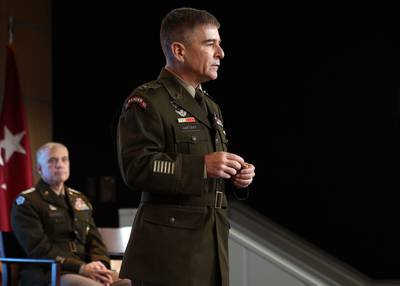We were tragically reminded recently when two separate accidents claimed the lives of 12 service members that we must not shortchange training and readiness of the force. In March, two Black Hawk medical evacuation helicopters crashed during a training exercise in Kentucky. Less than a month later, in April, two Army helicopters collided and crashed in Alaska.
While raising the debt limit is an urgent task, Congress is also discussing the readiness and safety of American forces as it prepares annual defense authorization and appropriations measures to fulfill its fundamental duty.
Maintaining and sustaining equipment and facilities, and persistently training in joint and coalition exercises, may not be as exciting as buying shiny new ships, planes, tanks and missiles, but it is crucial to a combat-credible operational fighting force and to the safety of those who populate that force.
According to the Defense Department’s fiscal 2024 budget overview: “Strategic readiness is the ability to build, maintain, and balance warfighting capabilities and competitive advantages that ensure the DoD can achieve strategic objectives across threats and time horizons.” The strategic framework used to develop the budget “expands the Department’s view of how it thinks about readiness” and “leverages tools and assessments to inform a broader understanding of the cumulative and cascading impact of decisions on readiness.”
The department is right: Useful data for decision-making is important. But while readiness can be a difficult thing to measure — particularly in understanding and balancing risk to force, to mission and to strategy — money is important, too.
Yet budgets for the operations and maintenance accounts that fund training and readiness have declined by close to 17% over the last 12 years. The cut is 50% for the Army. While some of this decrease can be attributed to a reduction in contingency funding for combat operations, the trend remains troubling and is further evidenced by the submission of $3 billion in unfunded priorities for these accounts. The Army’s unfunded list is notable in that it lacks a request for readiness and training funds, despite the fact it recently halted flight operations due to the accidents noted above.
Further emphasizing the damage of continued underinvestment in readiness efforts, the General Accountability Office recently reported that the Navy’s ship maintenance backlog has grown to nearly $1.8 billion, while maintenance and supply issues limit the availability of aging aircraft.
Shortfalls in funding for sustainment and modernization of facilities also directly contributes to readiness challenges. The military departments and combatant commands have reported a combined $3.4 billion infrastructure gap, and GAO reports continued backlogs in deferred facility maintenance of at least $137 billion.
In addition to the overall downward trend in funding, the operations and maintenance accounts are negatively affected by the impacts of continuing resolutions, which have been used by Congress to extend funding and priorities into the new fiscal year in all but three of the last 47 years.
The use of continuing resolutions, or CR, to keep the government running when annual appropriations are not passed on time results in lost time and billons in lost buying power each year. In the last 13 years, military competitiveness and readiness have been delayed for 1,600 days. Lost time can’t be recovered.
During testimony on the current readiness of the joint force before the House and Senate Armed Services committees this year, senior leaders of the military services all noted the importance of on-time budgets. Air Force Vice Chief of Staff Gen. David Allvin summed it up well, saying that “this Congress can make the most positive impact on our readiness through a timely budget appropriation. ... A CR will essentially rob us of something both critical and irreversible as we face growing threats to our nation. And that is time.”
Marine Corps Assistant Commandant Gen. Eric Smith added: “During any CR we are unable to improve as we otherwise would have done. Our adversaries don’t have that problem.”
While the DoD has also emphasized the importance of on-time budgets to enable the military services to properly plan training events and exercises, the current budget request does not adequately fund these activities.
The safety and readiness of the force is too important to get lost in clever language about decision frameworks, assessment tools, and balancing current and future needs.
Time is short: Only 37 joint legislative days are currently planned between May 12 and the start of the new fiscal year on Oct. 1, 2023. As congressional defense committees prepare to complete drafts of the FY24 authorization and appropriations bills in the coming weeks, it is crucial that they apply their knowledge and influence to support the current force by reversing the trend of declining operations and facilities funding, and that they provide these funds on time.
Elaine McCusker is a senior fellow at the American Enterprise Institute think tank. She is a former acting undersecretary of defense (comptroller).








